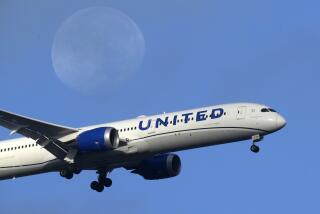FAA Blames Controller in Near-Collision
COSTA MESA â Last weekâs midair near-collision between an Alaska Airlines jet and a twin-engine plane near John Wayne Airport was caused by controller error, according to preliminary findings of the Federal Aviation Administration released Thursday.
FAA officials said the controller, a six-year veteran, was removed Thursday from his post, pending further investigation.
A review of enhanced radar tracks and voice tapes show that the controller failed to maintain proper separation between the two aircraft because he mistook one for the other and lost track of one of them, federal officials said.
âHe mistakenly believed that the Alaska jet was the Navajo,â FAA spokeswoman Elly Brekke said.
Brekke and FAA investigator Jim Miller said the incident took shape this way:
* A few minutes before Alaska Airlines Flight 240 from Seattle was scheduled to land at 6 p.m. Jan. 9, the controller cleared the Piper Navajo to land first. The Navajo was ferrying two businessmen to Orange County from San Diegoâs Montgomery Field. Forty-nine people were aboard the jetliner.
* Instead of making a sharp right turn onto the runway from a point just west and north of the airfield, as expected, the Navajo swung 1.2 miles off course to the east, over an industrial section of Irvine. Previous FAA estimates put the Navajo just a half-mile off course.
* Unaware of the Navajoâs wide swing, the controller--looking into the night sky--saw the lights of the rapidly descending Alaska Airlines jet, which was on course, but thought he was looking at the Navajo.
* Believing that the Alaska jet was missing and fearing that something was wrong, the controller told Navajo pilot Robert Akin to abort his approach and turn right, a maneuver that put the Navajo on a collision course with the still-descending jetliner.
* The startled Alaska Airlines pilot veered at the last minute to avoid a midair disaster over the San Diego Freeway, which was clogged with commuters.
âThe controller had mentally transposed the two aircraft,â the FAAâs Miller said.
He said he could not determine for sure whether, absent the Alaska pilotâs evasive maneuver, the two planes would have collided, because the radar equipment used is not precise enough.
Still, FAA officials Thursday revised the distance between the two aircraft at their closest point to 220 feet as they headed for the same runway.
Originally the air traffic controller told superiors the planes were a half-mile apart, but the FAA later said it tended to agree with Alaska Airlines pilot Edwin Jenkins, who had estimated that he missed the Navajo by just 100 feet.
Jenkins told his superiors that the incident was âtoo close for comfort.â
Several efforts to interview both pilots about the incident have been unsuccessful.
Alaska Airlines spokesman Greg Witter had no comment on the preliminary finding of controller error and only said his company âwants to make sure the air traffic control system works.â
The FAA declined to name the air traffic controller in the incident, citing federal privacy statutes.
Brekke said the investigation will continue, with the possibility that the controller will undergo further training before resuming duty.
Meanwhile, she said, the controller will perform work that is not related to safety.
During the incident, the tower was fully staffed with 11 controllers, Brekke said.
The FAAâs Miller said that both pilots had conversations with tower personnel after the incident but that no transcript of their comments is available.
The tower will have 30 days to add its own findings to the FAAâs investigation, Brekke said. Also, the FAAâs Office of Flight Standards will review the incident.
A final report is expected by mid-February.
More to Read
Sign up for Essential California
The most important California stories and recommendations in your inbox every morning.
You may occasionally receive promotional content from the Los Angeles Times.










